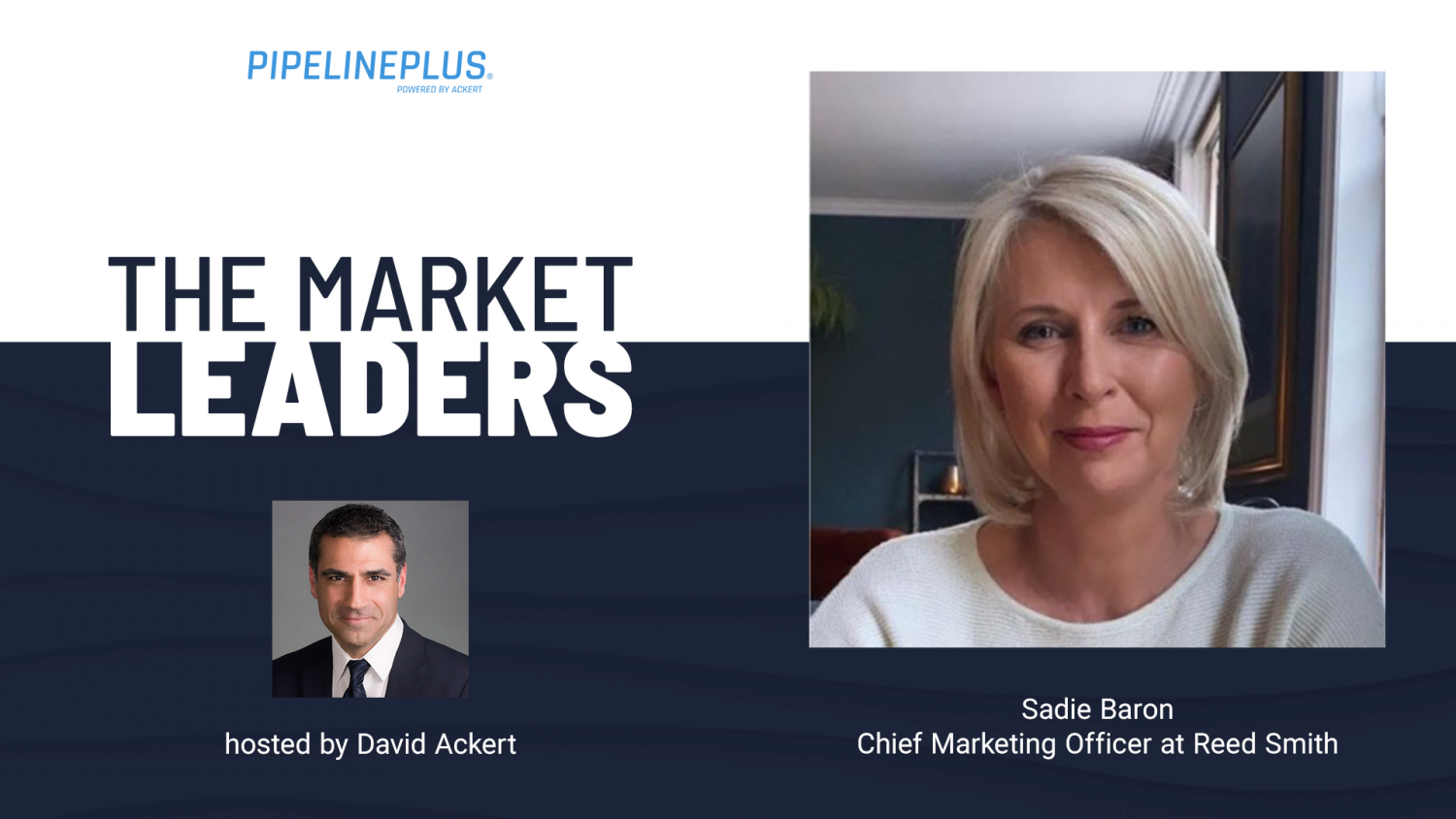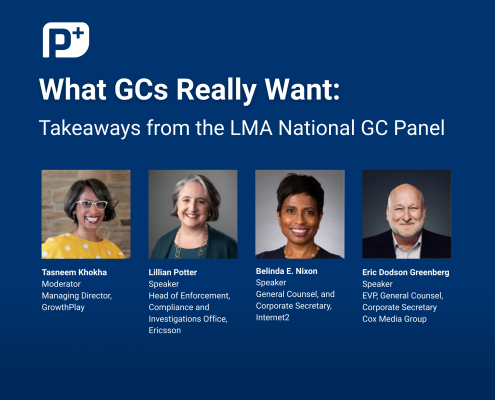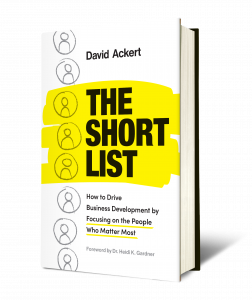“Differentiating the Firm in a Crowded Market” with Sadie Baron
Sadie Baron, CMO of Reed Smith, was our most recent guest on the Market Leaders Podcast. During the episode, she and David Ackert discussed the topic, “Differentiating the Firm in a Crowded Market.” Below is a recap of the conversation.
Asked to share a little bit about Reed Smith and her role there, Sadie began, “I think one of the things that we do really well is our industry-led approach. We’re very focused around that. And I think we have a very unique DNA at Reed Smith.”
Regarding her role, Sadie explained that she manages a considerable budget that includes things like Practice Development. She also manages a staff worldwide from San Francisco to Singapore and her team operates a very global approach to marketing, business development, and communications.
Differentiation
David noted that Reed Smith has a unique approach to differentiating itself from other Am Law 50 or 100 firms, who all seem to claim they have offices everywhere, a lot of excellent lawyers, and that they service a number of industries.
“I think we all talk about being client-centric and absolutely we are. Clients are at the heart of everything that we do,” Sadie commented. She shared that when she took on the CMO role at Reed Smith about six years ago, she and her team thought about how the firm should position itself in a very crowded market and wanted to figure out where they sat among the groupings of firms in the industry.
She explained, “There are the firms that are just big. They have 75 plus offices, and they’re pretty much in every corner of the earth. There are firms that want to be seen as being hugely innovative and cutting edge, and they can be more tech-led firms or some of the firms that have really big-brainy partners. Then, you have the firms that are boutique or niche, who perhaps only specialize in insurance or in litigation.”
“Then you’ve got this group of firms, like our own,” she continued, “who do all of that to some degree. So, you have to stop and ask yourself how you can genuinely set yourself apart.” Sadie noted that through research on the firm’s clients, staff, and competitors, she was proud to learn that Reed Smith is perceived as a nice firm to do business with.
She added, “Another thing that came through clearly in our research was that we are really quick to try and get to the heart of the matter. We don’t try and elongate things unnecessarily. We’re on the side of getting things done. What we are really here to do is to drive progress for our clients.”
Being Purpose Led
Sadie continued that when they got to that understanding it led the firm to a discussion about being purpose-led. “We asked ourselves why we get up in the morning, why we come to work, and what do we do every day. Now, purpose-led brands are nothing new, but in 2016, it was actually an emerging term, particularly within law firms.”
She added, “I’d love to make the claim we were the first law firm brand to move to being purpose-led, but I’m not sure I could genuinely say that. But the really big difference was that we stopped talking about ourselves and we started talking about what it is you get when you work with Reed Smith. What is it that we’re here to do? Why do we get up in the morning and come to work? And the thing about being progressive for me is not necessarily achieving one outcome, because progression to a client could be stopping something from happening. It’s not just this idea of always moving forward, but it’s about being outcomes-focused for us.”
Sadie reiterated that the way Reed Smith does this – and differentiates itself in the process – is by intensely focusing on just five key areas. She added, “This is right up there in my list of things that matter – having a true understanding of what it is you really want to focus on. If you’re trying to focus on 50 things, you’re never going to achieve that. The fact that we only focus on five really makes us able to look around the corner for our clients in a much more in-depth way than perhaps other law firms can.”
She explained that’s why Reed Smith ended up with driving progress and being a purpose-led brand as their differentiators and noted that those differentiators translate well across communities and staff because they can be internalized. She noted it’s also crucial to live up to the brand experience your firm promises, adding “I’m delighted six years on that we can still continue to build out the evidence that we are a purpose-led, driven, progressive law firm.”
Distilling the Purpose
David then asked Sadie how Reed Smith distills their purpose and if it’s to help the client progress and reach their goals or if they use any other specific language to communicate it.
Sadie responded, “We ask ourselves what we’re trying to achieve here, how are we trying to help our client get there, and what does it mean?” She admitted they’re still actively working on distilling the purpose and getting the firm’s own people to understand what’s meant by being purpose-led. She added, “It translates tactically into the advice we give clients and the way we give it. For example, we don’t want them to receive 17 pages of technical legal jargon, because research tells us what they really want is straightforward, to-the-point advice with an opinion that is going to help them make the decision they need to make. So, it’s also about the behavioral aspects of how we go about serving clients as a firm. And again, we have permission to say that because that’s what our clients told us they liked about working with Reed Smith.”
Sadie stressed that the idea of getting to the heart of the matter really quickly doesn’t mean Reed Smith can’t be tough or fast or big, thoughtful thinkers unraveling very complex legal matters when they need to be. It’s all about understanding what the client’s genuine needs and goals are.
DEI as a Differentiator
David then asked Sadie how DEI is also a differentiator for Reed Smith.
She responded, “I’m very proud of our track record in DEI. We do so much in this space, and I’d like to think that we have, again, been slightly ahead of the curve in terms of knowing the importance of diversity, not just from a race or gender orientation perspective, but also from diversity of thought on our client service teams.”
She continued, “We want to try and make sure that we’re bringing the most diverse team along, both in experience as well as all the other aspects of DEI. We’ve won many awards, but for me, you can’t take away the importance that clients are using DEI as a differentiator, and it’s been growing for a long time.”
Sadie explained that the events of George Floyd and others put an even greater spotlight on the need for firms to recruit diversely, maintain diverse talent, and educate entire workforces around the importance of diversity in all aspects. She commented, “We work really hard to make sure that we’re fielding the most diverse teams that we can. And our team has a big role in terms of business development and marketing, like making sure every panel we put on for client events is really representative. Nothing breaks my heart more than seeing an invitation go out that has not got a diverse group of experts, panelists, and speakers.”
Sadie shared that for a recent piece of thought leadership around Metaverse Two, they deliberately had a foreword written by trainees. She commented, “You could say, they’re not trained attorneys yet, so why are we letting them loose? We’re letting them loose because they really understand this subject matter. We’re not going to be held back because they haven’t fully qualified yet. They’ve got an opinion, and it’s valuable to us. And that’s what I mean about diversity of thought.” She added that sometimes you have to push through traditional hierarchies and blocks and protocols to bring diversity out because it matters so much to clients.
Sadie added, “I’d love to think in 50 or even 20 years we’re not having this conversation, but today, where we are in the market that we are when we’re thinking about differentiation, it’s important to me to bring every aspect of differentiation that you can – not only the color of someone’s skin but their lived experience. That is what is so important – that we bring that out in everything that we can do every single day. It’s at the heart of the strategy of the firm. It’s one of the main pillars of the firm. I’m sure pretty much every other law firm thinks about it in that way as well. I just think that what we are is a little bit more progressive in our thinking around how we use it.”
Agile Marketing
Finally, David asked Sadie to discuss a third differentiator that Reed Smith has borrowed from the world of tech start-ups, agile marketing.
Sadie explained, “This is something that’s really close to my heart. And, to be fully transparent, I’m not there yet, but it’s definitely something that’s part of my 2023 strategy.”
“Right now, if I want to respond really quickly to either a macroeconomic situation, or even something that’s perhaps a little bit more planned, like a Brexit, I have to go and beg, borrow, steal, and strong-arm volunteer members of my team into putting down their day jobs and turning their attention to whatever it is that we’re trying to do. And that’s just not sustainable for us to function because these are the topics that clients really want to know about, and they need fast responses.”
She continued, “So I’ve been toying with the idea of agile marketing for some time, and I was inspired by a wonderful lady I met last year who’s actually implemented it in her own law firm. I’m thinking about how I create an agile marketing resource within my headcount, like a special ops ninja team, not constrained by any of the hierarchy of my current function, and who probably report directly to me. It would be a team that I can deploy that would have a range of skills, like writing skills, digital skills, possibly some business development sales skills – a team where I could just point at something and say, look, this has happened, or this is something that’s really important.”
Sadie noted that she recently received an article about litigation funding. She said she immediately thought, “With the recession next year, what is that really going to mean? Can you de-risk this for clients? And that’s a complicated topic for us. We’re at every end of the spectrum on this, from the setting up of the funds to the defending of some of our major relationships, so we have to navigate our way through that. But wouldn’t it be fantastic if I actually had this little squad of people who I could say, Here’s the problem, here’s the response that I need. Go away and use agile marketing techniques. I want you to stress test it with clients. I want you to pivot or persevere. I want you to be fast to market. I don’t want you to report to anybody other than me on it.”
Sadie noted that she’s already ensured that this agile marketing approach would be signed off on by her global managing partner, so there aren’t huge levels of sign-off required that would impede progress. She admitted that this approach will mean she’s not going to be popular with everybody in the firm all the time, but she’s okay about that.
She explained, “What I am going to be is fast to market with opinion pieces that are going to help our clients navigate through these topics that matter to them in a really agile way. And when done, we’ll get the results, we’ll look at the ROI, we’ll see did it work, or did it not. Failing fast is fine with me. We’ll probably fail quite a bit on some of this stuff. It’s all right, we’ll move on.”
Sadie added that’s what law firms are going to have to get their heads around in a super fast, super changing world that is hugely unpredictable.
The Agile vs. the Traditional Approach
David pointed out that the agile marketing approach is in sharp contrast to how traditional firms operate and noted how critical it is that an agile group is unfettered by other commitments to be responsive and nimble.
Sadie responded, “I’m really lucky and I understand there are firms that haven’t got the resources I’ve got. I’m lucky enough to have a project management office as well we’ll be working really closely with because a huge part of the agile marketing process is project management.”
She continued, “I’m not an expert in it, I don’t understand all the terminologies. For me, though, the idea of having this resource does feel like a little bit of a luxury. In a constrained and uncertain market, to have three or four head people potentially carved out to do this feels brave. But I’ve really pushed for it, and I’m hopeful I’m going to get it, even if I have to carve it out of existing resources.”
Sadie explained that it’s important to break barriers, because currently, even for a very important topic like COVID, an average campaign takes three to six months. She commented, “That’s just too long. Clients have moved on from there. I’m not saying that there can’t be longer thought leadership pieces, like white papers and other activities you need to do, but there are also fast-to-market opinion pieces that are critical. If there’s something news-breaking you begin tracking, you’ve probably got only two to six weeks before you’ve got to get up a response, test it out, and either scale and deliver on it or stop and move on to something else.”
Giving it a Go
David commented that, while through the lens of how law firms think an agile marketing strategy seems wasteful, many technology companies have proven that there’s something to be said for the notion of dedicating smart people to look ahead of the curve and pull in the ideas, resources, and initiatives that will ultimately help an organization grow.
Sadie said thankfully her Global Managing Partner is very visionary, “We’ve been fortunate. We’ve actually employed some industry analysts, so we have that big-brain thinking perspective, and they can bridge the world of economics and politics, change, and law. When they’ve got these great ideas, which is what their job is to do, our job then is to take them to market.” She noted that, because of this, she thinks she’s got a fighting chance of making agile marketing work at Reed Smith.
“Thanks to having an excellent PMO and now brand new industry analysts who are going to add thought leadership, if we’re given ideas and the direction we need to go with them, I think we’re ready to take them on and give it a go.”
David noted that to keep agile marketing projects on track, a firm must have weekly stand-ups, regular communication, feedback loops, and the ability to take and apply learnings and adapt – principles that make sense in the context of getting things done, yet that are not traditionally integrated into the daily running of a law firm.
Sadie agreed, saying “No, they’re really not. And I understand the challenges as to why they’re not, which is why I’m quite determined that this group is going to report to me, and I’m going to report to my Global Managing Partner. I think if you try and build in too many checks and balances, you’re going to fail. You’ve got to have a super streamlined sign-off process. Yeah, we’re going to get it wrong and that’s okay. And that’s a really alien concept in law firms, the idea of failure.”
She added, “But for me, I’m okay with that as long as we’re not going to do anything that’s going to damage a client’s reputation or that’s absolutely fundamentally wrong. And I don’t think we’re going to be playing in that space because we will have had this input of these very sensible, thoughtful, and big-brained industry analysts. And, what’s the worst that could go wrong if something doesn’t work out as we say it’s going to? Okay, it was our opinion. Off we go. I’m good with that.”
Advice for Firms Interested in Agile Marketing
In closing, David asked Sadie what advice she would give law firms to at least begin thinking about leaning toward the concept of agile marketing.
Sadie advised, “Have a good think about things that you could stop, outsource, or get done somewhere else in the business. For the typical CMO, there’s a swathe of admin stuff that gets dumped into Marketing because there’s nowhere else for it to be done. I would encourage any leader of a marketing function to try and identify that and try and find the right home for it.”
Explaining how she went about doing this, she shared, “Basically every task that I came across that I knew we did in a marketing function, I wrote on a post-it note and stuck it on a wall. it looked like a yellow armadillo after about three months but what it enabled me to do was cluster some tasks together. It was a very simple technique, but it helped me work out what resources I needed and how I needed to right-size the team.
Sharing an added benefit of the exercise, she shared, “It was a really eye-opening exercise to do because partners would walk past my office and wonder what it was. Then they came in and started playing with it. So, I got real engagement through the process as well. A super simple tip is if you can find a way of getting engagement with the partners around doing more of the right things and less of the wrong things, it’s even better. Again, be brave and think about outsourcing.”
She continued, “Make sure that you are exceptionally good friends with your peers in the chiefs group. We operate as a group of chiefs, as one group, we support each other. I think building that relationship is super important if you want to be able to free up time within your own function.”
As a final word of advice, Sadie commented, “I would also say to ask for forgiveness rather than permission. I think sometimes just have a go and see what’s the worst that can happen. Be sensible about where you’re brave but try and carve out a project that’s going to make a difference because success breeds success.”







